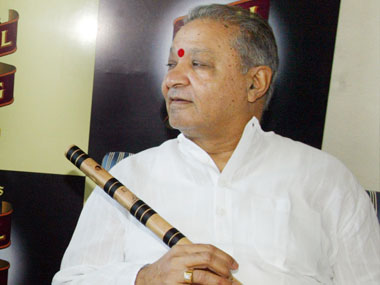Chasing Passion is the first of a four-part series distilling lessons from acclaimed masters across genres. In this series, we attempt to focus on synergies from their lives that can be applied in the corporate boardroom.
A brass bell hangs at the gate, which you ring to be let into the bungalow in Mumbai. Inside, refrains from a practice session can be heard as one waits for the flautist to emerge. Waiting for the 77 year-old maestro, Pandit Hariprasad Chaurasia is no hardship, because it gives you a chance to listen to the legendary musician honing a talent that has mesmerised listeners over the decades.
A door opens: Pandit_ji_, as he is known by his admirers, can be seen with his students. After telling them to continue practising, the maestro – dressed in a blue lungi and a short, white kurta – comes out for the interview.
Before a question can be posed to him, he raises one of his own: “What do you think businessmen can learn from my music?” he asks with a laugh. “There is nothing to learn from me, is there?”
Except, of course, there is. In Chaurasia’s story and the principles by which he has lived and taught music, there’s a refreshing focus upon valuing essentials, rather than getting distracted by hype. The flautist embodies a combination of determination, self-assuredness and humility that is rare.
From a tender age, Chaurasia knew he was meant to be a flautist, even though the flute was not considered versatile enough for Hindustani classical. Yet, Chaurasia persisted and made a name for himself as well his chosen instrument, all the while retaining both his conviction in his talent and his humility before his guru.
Clarity of purpose Chaurasia’s well-chronicled journey starts with his famous wrestler father’s desire to get his son on the mat. “But I was not good at that,” he says.
Chaurasia reveals the first step he took to learn music, surreptitious though that was considering he was only around 8 years old. “My father felt music was what courtesans did at _mehfil_s. So it was taboo. To please my father I would go to the ring and wrestle.”
After an exhaustive practice that pummeled his muscles, Chaurasia would go off to a friend’s house whose parents encouraged the young wrestler’s love for music.
The flute came much later into Chaurasia’s life. He heard it for the first time on radio when he was 15 years old. “I realised then that is what I wanted to do and went in search of the artist, Pandit Bholanath,” he says. He convinced the established flautist to give him music lessons.
The practice sessions could not be hidden from Chaurasia’s father for long. “One day my father heard me play and was livid. I was lucky to get a job as an artist soon at Cuttack radio, Orissa and my father allowed me to take that up. Since I began learning music, there has not been a single day of boredom. I was learning it to satisfy my soul,” he explains.
Finding teachers or mentors who can guide the student to unlock his potential is a rite of passage in itself. But what is important, says Chaurasia, is for the teacher to learn to let go of the student after the latter has realised his potential. “All my teachers allowed me to grow and learn from others.” That, he says, is the key to allow talent to grow and flourish.
Finding your passion
The Aha moment, says Chaurasia, is for an individual to know what drives and consumes his waking hours. “I am glad I realised I love music and learnt to play the flute early in life. Each of us has that one thing we can do exceedingly well. I feel we should identify that and live for it, irrespective of our circumstance.”
Music in India has its roots in the well-hewn path of a guru-shishya parampara. The guru to whom Chaurasia surrendered as a shishya was to the reticent Annapoorna Devi, daughter of Allaudin Khan of the Maihar gharana and wife of the late sitar maestro Pandit Ravi Shankar. Chaurasia persisted for three years before Devi agreed to teach him. Her condition? He must unlearn all that he had learnt until then. Chaurasia didn’t resist. He switched from playing the flute from his right hand to the left. “I have always played with my left hand since then,” he says.
The keenness to learn from Devi was far greater than his urge to play the way he always had. It also meant learning something new. “I have played with my left hand since then.”
Honor the mentor
Chaurasia’s voice and expressions change as he talks about his teacher. Narrating an incident, he says, “When I go to my guru for my weekly lessons, she asks me to reveal a new vision from the same raag she has taught me earlier. Sometimes she refers to a lesson given a few years back.” And then, he says softly, “I get nervous by the task.”
For a whole week before his next class, Chaurasia spends his time, when not teaching or listening to his students, practicing to get his own music pitch perfect. When it is time to play the tune he has worked on for his guru, he does what any student hopes to – he tries to deliver what is expected of him. He smiles when asked what his guru’s reaction is. “My guru listens and says just one word, Ok. Then I am told, It (the tune) can be made more beautiful or Come back with another vision.”
When the guru asks for another vision, what she means is to improvise, explains Chaurasia. This ‘improvisation’ is what makes Indian music unique, he says. “Our music does not ask us to become a copy or a replica of the teacher. So when my teacher says come back, what she means is build another story around the raag.”
The lessons begin all over again and he is still at it, he says, looking forward to his weekly lessons to `learn something new’. Something new from one raag – Raag Yaman, that Chaurasia has been practicing with his guru for the last 30 years!
If good, encore follows
In an age where the packaging is as important, if not more, than the product, how does one sell it? Having a good product is its own brand image, believes Chaurasia. “If what you have done is out of passion and has given you joy while creating it and even after, it is bound to stand out. You don’t have to work hard to scream your presence,” he says.
Learn to let go
It is only a chosen few in an organisation who get the carrots. It is not always for a work well done or the talent to handle work but also to ensure that they don’t leave when an opportunity presents itself. Chaurasia says it is important to teach everything and then let go of the students.
“I want my students to grow the music they are learning here. They should uphold the tradition, the gharana and teach others. I want them to be better than me. When they outdo me, I am their best teacher. Else, I have not succeeded.”
That is quite a leadership lesson; but how many in the corporate world do you know who do that?


)




)
)
)
)
)
)
)
)